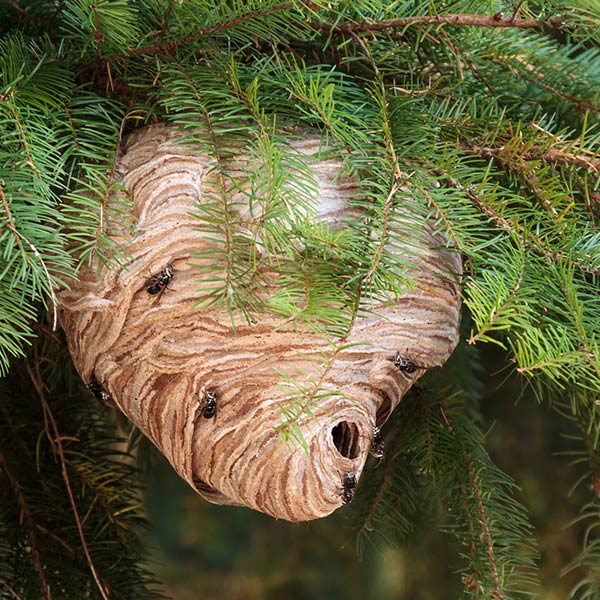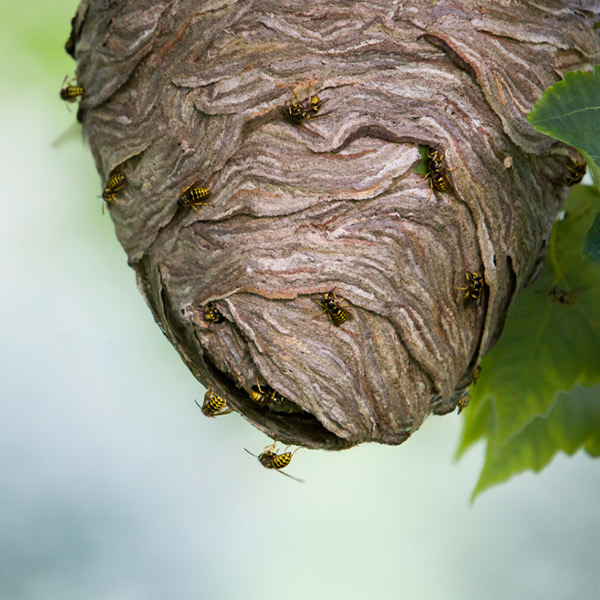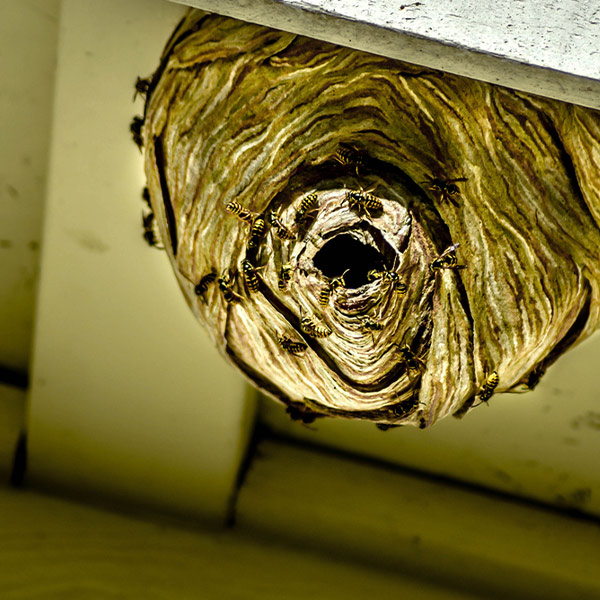Tips for Effective Calgary Wasp Removal
Wasps may seem like a common inconvenience at backyard picnics, but their presence can pose significant risks to your health and property. Effective wasp removal is essential in Calgary to ensure safety and prevent potential harm. In this blog post, we will guide you through the intricacies of Calgary wasp removal services, such as Ecopest Pest Control, the aggressive nature of wasps, differentiating between bees and wasps, wasp nest removal techniques, and preventive measures. Let’s dive in and discover how to tackle these menacing insects head-on!
Short summary
Professional Calgary Wasp Removal Services are available to protect you from potential harm.
Understanding wasps and their potential dangers is important for prevention and addressing infestations.
Ecopest Pest Control in Calgary offers professional, safe pest control services with over two decades of experience.
Contact Us Today!


Calgary Wasp Removal Services
Wasp infestations in Calgary are a serious concern, and dealing with them can be daunting. A professional wasp exterminator is crucial to safely and effectively removing wasp nests. These experts are well-versed in identifying infestations, understanding the dangers posed by wasps, and employing the best approach for wasp extermination.
With the right help, you can eliminate these stinging insects and reclaim your space from their aggressive presence.
Identifying a Wasp Infestation
Recognizing a wasp infestation is the first step toward addressing the issue. Some signs to look for include increased wasps flying around your property, nests attached to structures, or even wasps entering and exiting small gaps in walls or roofs. Yellow jackets, for example, often build their nests on the ground or behind walls and in attics. It’s essential to be vigilant and watch for these signs to tackle the problem early and effectively.
When you spot a wasp infestation, prompt action is crucial. However, it’s important not to disturb the nest or attempt removal alone, as wasps can become aggressive when threatened. Instead, contact a professional wasp exterminator to assess the situation and provide expert guidance on the best action.
Hiring a Professional Exterminator
Hiring a professional exterminator is wise when dealing with a wasp infestation. These experts possess the knowledge, experience, and equipment to safely and effectively remove wasp nests. They can accurately identify the species of wasp, the size and location of all the wasps nest, and determine the most appropriate treatment plan.
Attempting to remove a wasp nest on your own can be risky, as wasps can become aggressive and sting multiple times, causing pain, swelling, and even severe allergic reactions. Professional exterminators ensure the safe removal of wasp nests, protecting you and your family from potential harm.
Don’t take chances with your safety – trust the experts to handle your wasp problem.
Understanding Wasps and Their Dangers
Wasps are infamous for their aggressive behaviour and painful stings, which can lead to swelling, discomfort, and even severe allergic reactions. With a distinct head, large compound eyes, and a long stinger, their appearance alone can be intimidating. Unlike bees, which primarily serve as pollinators, wasps are predators that consume other insects, and they can be highly territorial and protective of their nests. Among the various wasp species, these traits are pretty common.
Understanding the dangers wasps pose and the importance of addressing infestations promptly and professionally is crucial. Taking steps to prevent wasps from entering your home or business is essential for protecting your home or business.
Aggressive Nature of Wasps
One reason for the wasp’s reputation as a fearsome insect is its ability to sting multiple times without dying, unlike bees, which can only sting once. This makes the wasps dangerous and more likely to attack repeatedly until they perceive the threat to be eliminated, posing a significant risk to anyone nearby.
Wasp stings can be painful and cause swelling and discomfort, but they can be particularly dangerous for individuals with allergies. A wasp sting can sometimes trigger a severe allergic reaction, leading to difficulty breathing and even death.
This is why it’s essential to be cautious around wasps and seek professional help when dealing with an infestation, as dangerous behaviour can pose a threat.
Wasp Stings and Allergic Reactions
A wasp sting can be a painful experience, but it can also lead to severe allergic reactions for some. Symptoms of such reactions can include:
Difficulty breathing
Swelling of the face or throat
Rapid or weak pulse
Dangerous drop in blood pressure
An allergic reaction to a wasp sting can be fatal in extreme cases.
If you or someone you know experiences an allergic reaction to a wasp sting, it’s crucial to seek medical attention immediately. This underscores the importance of engaging a professional exterminator to handle wasp infestations, as they possess the expertise and equipment necessary to remove nests safely and minimize the risk of stings.
Differentiating Between Bees and Wasps
While bees and wasps may appear similar at first glance, they serve different roles in the ecosystem and exhibit distinct behavioural patterns. Bees are vital pollinators of flowering plants, while wasps are predators that consume other insects. Understanding the differences between these two insects is essential for effective removal and prevention strategies.
Let’s delve deeper into these differences by examining honey bees and yellow jackets, unlike honey bees and other stinging insects.
Honey Bees vs. Yellow Jackets
Honey bees and yellow jackets exhibit notable distinctions in appearance, behaviour, and nesting habits. Honey bees are generally golden-brown and measure approximately one inch long, whereas yellow jackets have bright yellow and black markings and are slightly over half an inch long. Additionally, honey bees are less aggressive and can only sting once, while yellow jackets are more aggressive and can sting multiple times.
When it comes to nesting, honey bees create hives that can be safely relocated, while yellow jacket nests are often found on the ground under trees or behind walls and cannot be relocated. Understanding these differences is crucial when dealing with infestations, as it can inform the best approach for removal and prevention.
Other Stinging Insects
In addition to yellow jackets and honey bees, Calgary is home to other stinging insects, including the bald-faced hornet and bumblebees. Bald-faced hornets are typically black and white, measuring around 5/8 to 3/4 inches. On the other hand, Bumblebees are larger and fluffier than honey bees, hornet or wasps and are known for visiting the same patch of flowers daily until the nectar supply is exhausted.
While these insects may not be as aggressive as yellow jackets, they can still pose a threat if their nests are disturbed. As always, it’s best to consult a professional exterminator for safe removal and prevention strategies.

Wasp Nest Removal Techniques
Removing a wasp nest can be a challenging and potentially dangerous task. It’s essential to employ the appropriate techniques for removing wasp nests, including hornet removal, to ensure a safe and effective process. To handle a wasp nest properly, one must take necessary precautions and follow expert guidelines.
Let’s explore some of the methods professionals use, including protective equipment and natural removal methods.
Protective Equipment and Tools
Safety should always be a top priority when it comes to wasp nest removal. Wearing protective gear, such as bee suits, gloves, and face masks, can significantly reduce the risk of stings during removal. Professional exterminators also employ commercial-grade tools, such as wasp traps and specialized equipment, to safely and effectively remove nests.
Adhering to safety protocols and utilizing appropriate protective equipment and tools is crucial to ensure the success of the removal process and minimize the risk of injury. Trust the experts to handle your wasp infestation with the utmost care and professionalism.
Natural Wasp Removal Methods
In some cases, natural wasp removal methods can be employed to safely remove nests without causing harm to the environment or other animals. Some examples include using soap and water, hanging wasp traps, or applying non-toxic insecticides to the nest.
One important factor to consider when using natural removal methods is the timing of the treatment. Wasps tend to be less active at night and fall, making it an ideal time to remove the nest. Remember, however, that attempting to remove a nest on your own can still pose risks, and it’s always best to consult a professional exterminator for guidance and assistance.
Preventing Wasp Infestations
Preventing wasp infestations is just as important as addressing existing ones. By proactively sealing gaps and holes in your property and practicing proper food storage and waste management, you can minimize the likelihood of wasp infestations and maintain a safer environment for you and your family.
Taking the time to inspect your property for potential entry points and taking steps to seal them off.
Sealing Gaps and Holes
To prevent wasps from entering your property, it’s essential to inspect your home for gaps or holes, particularly around:
windows
doors
vents
chimneys
Sealing these gaps with caulk or expandable foam sealant can deter wasps from accessing your property and building nests.
Another useful preventative measure is to cover vents and chimneys with mesh screens. This can prevent wasps from entering while still allowing air to flow through. Addressing potential entry points can significantly reduce the risk of wasp infestations.
Proper Food Storage and Waste Management
Wasps are attracted to food sources, making proper food storage and waste management essential for minimizing wasp activity and attraction. Here are some tips to follow:
Store food in sealed containers, keep it in the refrigerator or freezer and promptly clean up any spills or crumbs.
Dispose of food waste in tightly sealed containers and avoid leaving it out for extended periods.
Regularly clean up any food waste that may have accumulated.
Keep garbage cans and compost bins away from your home or business.
By practicing these preventive measures, you can help with wasp control, keeping wasps at bay and maintaining a safer environment for you and your family.
Selecting a Wasp Extermination Service in Calgary
Choosing the right wasp extermination service in Calgary is crucial to ensuring effective and lasting results. This section will guide you through selecting the best service for your needs.
We will focus on experience, customer reviews, and reputable Ecopest Pest Control.
Experience and Expertise
When selecting a wasp extermination service, it’s important to consider the following:
The experience and expertise of the provider
Their ability to accurately identify the species of wasp
Their knowledge of the size and location of the nest
Their ability to determine the most effective methods for removal
By considering these factors, you can ensure that you choose a knowledgeable and experienced exterminator for effective wasp removal.
An experienced exterminator will be familiar with the latest pest control methods and use only the safest and most effective products. Trusting an experienced professional with your wasp removal needs ensures that the job will be done safely and efficiently, minimizing the risk of harm to you and your property.
Customer Reviews and Testimonials
Customer reviews and testimonials can be vital in selecting a reliable wasp extermination service. These reviews offer an impartial viewpoint from past customers, providing valuable insights into the quality of service offered.
When evaluating customer reviews, consider factors such as:
Promptness
Professionalism
Friendliness
Overall satisfaction with the service
By taking the time to research and compare different extermination services based on customer feedback, you can make an informed decision and choose the best provider for your needs.


Ecopest Pest Control - Calgary
Ecopest Pest Control is a trusted and experienced wasp extermination service in Calgary. They offer a range of services, including:
Pest control
Tree spraying
Sanitation
Treatments for various pests like ants, bed bugs, cockroaches, and wasps
With over two decades of experience in the industry, Ecopest Pest Control’s team of certified technicians is well-versed in the latest pest control methods. It uses only the safest and most effective products.
Customers have praised the company for its prompt, professional service and reasonable rates. When it comes to wasp removal in Calgary, Ecopest Pest Control is an excellent choice.
Summary
In conclusion, dealing with wasp infestations in Calgary requires a thorough understanding of wasp behaviour, proper removal techniques, and preventive measures. Hiring a professional exterminator with experience and expertise is crucial for safe and effective wasp removal. By taking proactive steps to prevent infestations and selecting a reliable extermination service, you can protect your property and ensure your family’s safety.
Remember, wasp infestations are not to be taken lightly. Don’t hesitate to seek professional help if you suspect a wasp problem, and take action to prevent future infestations. Together, we can create a safer, wasp-free environment for all.
Frequently Asked Questions
Why are there so many wasps in Calgary this year?
COVID-19 home renovation projects, wet spring weather and heat combination, and a dry, warm early spring have all contributed to an unusually large presence and colony of wasps in Calgary this year.
This winter, warm weather has facilitated more insects, larger nests, and food for the wasps.
Can you permanently get rid of wasps?
You can eliminate wasps by using methods such as hanging traps, spraying nests, and making a mixture of soap and water. For long-term results, hiring a professional pest control or expert to destroy existing nests and apply treatments to prevent re-infestations is recommended.
What’s the easiest way to get rid of a wasp?
The easiest way to get rid of a wasp is to use WD-40 to kill it and prevent it from returning or use a mixture of two tablespoons of dish soap and water to clog its breathing pores.
This method is practical and easy to use, and it will help keep wasps away from your home.
How do I get rid of wasps in my area?
Remove any attractants build nests, set up wasp traps, hang deterrents, spray nests, use a soap and water mixture, try a DIY trap, kill individual wasps, and treat future nesting areas to eliminate wasps in your area.
Taking the right steps can help you eliminate wasps in your area. Start by removing any attractants that may be drawing them in. Set up wasp traps, hang deterrents, and spray nests to help reduce the population.
You can also use a soap and water mixture to kill individual wasps. If not, then you would be disappointed.
How can I identify a wasp infestation on my property?
Look for increased flying wasps, nests on structures, or small gaps in walls and roofs from which wasps enter and exit to identify a wasp infestation on your property.
Pay attention to these signs, as they can indicate a wasp infestation. If you notice any of these signs, it is important to take action quickly to prevent the infestation from worsening.